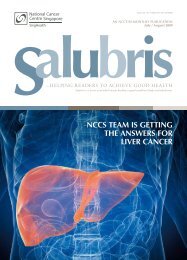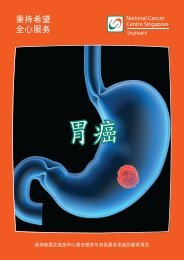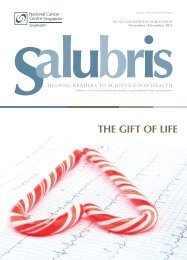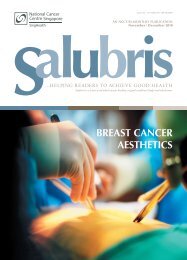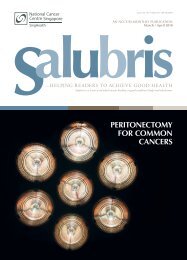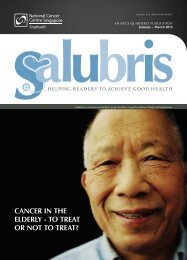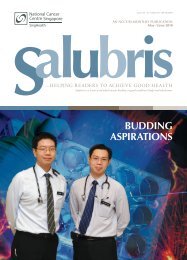Medical Professionals Version - National Cancer Centre Singapore
Medical Professionals Version - National Cancer Centre Singapore
Medical Professionals Version - National Cancer Centre Singapore
Create successful ePaper yourself
Turn your PDF publications into a flip-book with our unique Google optimized e-Paper software.
Issue No. 05 • MICA (P) 207/10/2008<br />
AN NCCS BI-MONTHLY PUBLICATION<br />
July / August 2009<br />
...HELPING READERS TO ACHIEVE GOOD HEALTH<br />
Salubris is a Latin word which means healthy, in good condition (body) and wholesome.<br />
NCCS TEAM IS GETTING<br />
THE ANSWERS FOR<br />
LIVER CANCER
PAGE A2<br />
In Other Words<br />
FOR THE LOVE OF SCIENCE<br />
SALUBRIS<br />
July / August 2009<br />
DANIEL TAN speaks about his passion for science which<br />
led him to his research into how targeted drug works<br />
in nasopharyngeal cancer. CAROL ANG reports.<br />
Recently, the Department of <strong>Medical</strong> Oncology welcomed back two doctors.<br />
Amongst them is Dr Daniel Tan, who had been away for a nine-month<br />
fellowship programme in the UK. He is the second doctor to return from<br />
overseas, the first this year being Dr Ng Quan Sing. Five other doctors,<br />
namely, Dr Lynette Ngo, Dr John Chia, Dr Richard Quek, Dr Wong Nan Soon<br />
and Dr Ang Mei-Kim are still overseas and not due to return till 2010.<br />
Dr Tan is the first oncologist<br />
from <strong>Singapore</strong> to be conferred<br />
the Young Investigator Award<br />
from the American Society of Clinical<br />
Oncology (ASCO) <strong>Cancer</strong> Foundation.<br />
This award provides funding to promising<br />
investigators planning an investigative<br />
career in clinical oncology.<br />
Recalling fondly his stint overseas,<br />
Dr Tan revealed, “In my second year<br />
of study at St Bartholomew’s and<br />
The Royal London Hospital, we had<br />
8-week elective projects – ranging from<br />
library-based to lab-based ones – and<br />
out of curiosity, I picked the latter and<br />
ended up in the then Imperial <strong>Cancer</strong><br />
Research Fund at Lincoln’s Inn Fields.<br />
I was fortunate to have a very good<br />
mentor who showed me how research<br />
can challenge scientific dogma, with<br />
the aim of making a difference in<br />
patient care.” Dr Tan’s enthusiasm for<br />
knowledge was so great that he even<br />
took a year out to do an intercalated<br />
BSc degree in tumour biology.<br />
It is precisely this investigative spirit<br />
and an avid interest in making new<br />
discoveries that has brought Dr Tan<br />
to his current vocation as oncologist<br />
and clinician-scientist at the NCCS.<br />
Nursing a passion for Science<br />
since he was a child, Dr Tan knew<br />
his dream job would be one that<br />
allows him to apply knowledge in a<br />
practical meaningful way. “Medicine<br />
provided the right mix of human<br />
interaction and applied science,”<br />
he said. And, at the age of 16, Dr Tan<br />
started medical school in London<br />
and now holds BSc (Hons), MBBS<br />
and MRCP qualifications.<br />
He returned in 2002 to be enrolled into national service where he spent a year in the Diving<br />
Medicine Section. In 2004, Dr Tan joined SingHealth, and undertook the rotations through<br />
various departments as a medical officer at the <strong>Singapore</strong> General Hospital. Three years<br />
later, he began his career in oncology but took off again shortly on a <strong>National</strong> <strong>Medical</strong><br />
Research Council Fellowship to the Drug Development Unit of The Royal Marsden Hospital,<br />
a leading cancer centre in the UK, with full support and encouragement from the NCCS.<br />
For this, he gratefully acknowledges the medical oncology department for creating a highly<br />
conducive environment for personal development, where peers and seniors work towards a<br />
common goal to deliver better care and treatment options to patients – and early phase trials<br />
may be a way forward.<br />
“During my nine months there, I learnt how to innovate the design of Phase I trials, care for<br />
participating patients, as well as interact with pharmaceutical companies and collaborating<br />
overseas Phase I units in Europe and US. It was also quite an experience prescribing novel<br />
drugs available at the unit, knowing well that some of them might become the standard of<br />
care in the next five to 10 years.” He further recounted that some patients could be seen to<br />
benefit even in the context of Phase I trials, which are traditionally regarded as dose titration<br />
experimental studies. “In the era of targeted therapy, and non-invasive molecular platforms,<br />
there is now scope to rationally improve the chances of patient benefit from novel drugs, as<br />
well as gain insight to basic tumour biology.”
PAGE A3<br />
In Other Words<br />
SALUBRIS<br />
July / August 2009<br />
“Despite the slew of<br />
exciting drugs coming<br />
through, we remain<br />
cautiously optimistic,<br />
and at the end of the day,<br />
patient care and safety<br />
remains the priority.“<br />
Dr Daniel Tan<br />
However, beyond the high tech<br />
translational science, he added “I<br />
would say I still derived the greatest<br />
satisfaction treating patients and seeing<br />
them get better. Some of the patients I<br />
met at the hospital were also refreshingly<br />
enlightened. They participated in trials<br />
with the hope of helping others even<br />
though there was a chance that it would<br />
not benefit them,” he added.<br />
As the Young Investigator Award is given<br />
to applicants during their transition<br />
from a fellowship programme to a<br />
faculty appointment, it was shortly<br />
before he returned to <strong>Singapore</strong> that he<br />
received this honour.<br />
“I am glad that the proposal came<br />
through the peer-review process and was<br />
selected for funding by a highly regarded<br />
international scientific body. The most<br />
satisfying part is to have articulated an<br />
idea in the proposal and have someone<br />
take it seriously to the extent of providing<br />
funding, all in good faith,” he said.<br />
The grant from the award would go into<br />
his research on ‘Delineating Clinically<br />
Relevant Targets of Anti-Angiogenic<br />
Small Molecule Tyrosine Kinase Inhibitors<br />
in Nasopharyngeal Carcinoma’.<br />
“To put that simply, I am trying to<br />
understand why resistance develops in<br />
drugs targeting blood vessels, as well as<br />
find out how they work in nasopharyngeal<br />
cancer which affects about 400<br />
<strong>Singapore</strong>ans each year,” he explained.<br />
Now that Dr Tan is back, the clinicianscientist<br />
has to divide his time between the<br />
NCCS-VARI Laboratory, where he works<br />
with his mentor Prof Teh Bin Tean, and<br />
the clinic where he sees patients suffering<br />
from a range of different tumour types.<br />
Dr Tan was upfront about his role as an<br />
oncologist. “At first, I had reservations<br />
about a lifelong career in oncology.<br />
But I soon found it to be both a<br />
privilege and an extremely fulfilling<br />
undertaking to care for cancer patients.”<br />
Indeed for someone who is developing<br />
new drugs in oncology, Dr Tan remains<br />
circumspect on the role of a physician.<br />
“Despite the slew of exciting drugs<br />
coming through, we remain cautiously<br />
optimistic, and at the end of the day,<br />
patient care and safety remains the<br />
priority. Hopefully, our research efforts<br />
will shed some light to the current gaps<br />
in understanding cancer, and ultimately<br />
translate to improved care for patients.”<br />
Off work, this 31-year-old is on a constant<br />
quest to discover new gastronomic highs.<br />
He regularly goes for runs, waxes lyrical<br />
about wine together with good friends,<br />
and challenges himself to a therapeutic<br />
game of golf, when time avails.<br />
By Carol Ang
PAGE A4<br />
In Focus<br />
SALUBRIS<br />
July / August 2009<br />
NCCS TEAM IS GETTING THE<br />
ANSWERS FOR LIVER CANCER<br />
The NCCS team has come up with a modality to test drug<br />
combinations in laboratories and today their work has found<br />
its way to the patients who are on clinical trials. At the onset<br />
of this trial, a biopsy of the tumour from the patient was first<br />
taken and implanted into a mouse. The mouse underwent<br />
treatment with the use of one drug and its progress was<br />
monitored. Subsequently, other drugs were administered<br />
until the desired result was obtained.<br />
Thus far, the team has tested a combination of two drugs, both of which are produced by two different giant pharmaceutical companies, for liver<br />
cancer. The combination of two drugs was found to be more effective than the use of one drug. Based on this discovery, a Phase I clinical trial<br />
testing on liver cancer patients for this two-drug combination was conducted. Twenty-seven patients participated in this trial and the results were<br />
encouraging, with complete shrinkage of the tumour in a few patients. A Phase II trial will be launched on some 59 patients later this year.<br />
The team behind this timely<br />
discovery comprises of Adjunct<br />
Professor Huynh Hung from<br />
the NCCS Humphrey Oei Institute of<br />
<strong>Cancer</strong> research (Division of Cellular<br />
and Molecular Research) and clinician<br />
investigators Dr Toh Han Chong, Head<br />
of the Department of <strong>Medical</strong> Oncology<br />
and Dr Choo Su Pin, Consultant for the<br />
Department of <strong>Medical</strong> Oncology.<br />
Professor Hui Kam Man, Director, Division<br />
of Cellular and Molecular Research at<br />
NCCS said: “We could not have achieved<br />
this without the financial support from the<br />
<strong>Singapore</strong> Millennium Fund, the <strong>National</strong><br />
<strong>Medical</strong> Research Fund and the <strong>Singapore</strong><br />
<strong>Cancer</strong> Syndicate. They could see the<br />
significance of our project and gave us the<br />
necessary funding to make this a reality.”<br />
The team’s success has prompted more<br />
drug companies to come together and<br />
use NCCS as a platform to best their drug<br />
combinations. More clinical trials are in<br />
the works.<br />
However, exemplary treatment<br />
methods are futile if patients are late<br />
in seeking medical attention. Majority<br />
of liver cancer fatalities could have<br />
been prevented with early detection.<br />
Thus, for NCCS’s 2nd Liver <strong>Cancer</strong><br />
Awareness Campaign in September<br />
this year, great emphasis was placed<br />
on raising public awareness and<br />
encouraging more people to do<br />
health screenings.<br />
To reach out to more households,<br />
public forums will be held at the Paya<br />
Lebar Kovan Community <strong>Centre</strong> on 12<br />
and 13 September 2009. The forums<br />
will be presented in English and<br />
Mandarin. All attendees are entitled<br />
to free goodie bags and vouchers for<br />
free Hepatitis screenings at SingHealth<br />
Polyclinics. Madam Cynthia Phua,<br />
MP for Aljunied GRC, who will be<br />
launching the LiCAM campaign urged<br />
the public to go for regular medical<br />
screenings, their best defense against<br />
the disease.<br />
The campaign will focus on information<br />
on the latest treatment methods and<br />
care for liver cancer patients, the risk of<br />
Hepatitis and how to avoid contracting<br />
fatty liver. Fatty liver is a condition that is<br />
likely to become more common among<br />
affluent <strong>Singapore</strong>ans.<br />
It is expedited when fat accumulates in<br />
Hepatocytes, or tiny sacs of liver cells.<br />
Although fatty liver is a benign condition,<br />
it can give rise to a wide spectrum of<br />
liver diseases, lead to inflammation and<br />
scarring of the liver and eventually, liver<br />
cancer if left undetected. The campaign is<br />
sponsored by Bayer Healthcare.<br />
Dr Tan Yu Meng, Deputy Head and Senior<br />
Consultant, Department of Surgical<br />
Oncology, NCCS and Surgical Director,<br />
Liver Transplant Programme, SGH, who<br />
spearheads the Liver <strong>Cancer</strong> Awareness<br />
Month Committee said, “Early detection<br />
is the best solution for liver cancer<br />
as often by the time the patients are<br />
brought to our attention it is too late for<br />
treatment. Hence, we hope to raise public<br />
awareness so that they will come forward<br />
and take advantage of the free screening.”<br />
With greater public<br />
awareness and improved<br />
cancer treatments, liver<br />
cancer patients may<br />
look ahead with lighter<br />
hearts as NCCS brings its<br />
research work from the<br />
bench to the bedside.
ADVANCES IN RADIOTHERAPY<br />
IN THE MANAGEMENT OF<br />
EARLY PROSTATE CANCER<br />
PAGE C1<br />
Under The Microscope<br />
SALUBRIS<br />
July / August 2009<br />
INTRODUCTION<br />
Prostate cancer is a cancer whose incidence has been<br />
steadily increasing over the last 35 years. It is typically<br />
found in men older than 50 years but its incidence<br />
varies greatly around the world. In <strong>Singapore</strong>, it is<br />
now the 3rd most common male cancer.<br />
By Dr Terence Tan<br />
Sr Consultant Radiation Oncologist,<br />
Dept of Radiation Oncology,<br />
NCCS<br />
Early prostate cancer refers to cancer confined to the prostate (stage I & II) and these may be managed<br />
by surgery, radiotherapy or active surveillance. Locally advanced prostate cancer on the other hand is<br />
best treated by a combination of androgen suppression therapy and radiotherapy.<br />
This article looks at advances in the use of radiotherapy in the management of localised prostate cancer.<br />
DOSE<br />
It is now generally accepted that there is a doseresponse<br />
curve for prostate above the conventionally<br />
given 66 Gy. Studies from the Memorial Sloan-<br />
Kettering <strong>Cancer</strong> Center and M.D. Anderson <strong>Cancer</strong><br />
Center have shown that patients have improved<br />
relapse-free survivals when given doses above 70<br />
Gy. While studies into the delivery of even higher<br />
doses are on-going, the current recommendation is<br />
for doses of at least 74 Gy (minimum tumour dose)<br />
to be delivered.<br />
Dose escalation studies began in the era of 3-D<br />
conformal radiotherapy and it was noted that<br />
while increases in the total dose delivered to the<br />
tumour improved disease-free survival, rectal and<br />
bladder morbidity rates also increased. That was<br />
until the advent of Intensity Modulated Radiation<br />
Therapy (IMRT).<br />
IMRT<br />
Intensity modulated radiotherapy is a very sophisticated form of radiation where<br />
the cross-sectional exposure of each treatment beam is not uniform as in the<br />
past but is varied by computer control (intensity-modulated) such that parts of<br />
the beam passing through sensitive normal structures have reduced exposure<br />
rates while parts which pass through tumour and not normal tissues have higher<br />
exposure rates.<br />
In this way, when a number of such treatment beams are arrayed around the<br />
patient, the high-dose treatment volume can be made to envelope the tumour<br />
target volume very conformably while sparing the surrounding normal tissues to<br />
a degree even greater than the previously used 3-D conformal techniques.<br />
Even within the treatment volume, it is possible to vary the dose (dose-paint),<br />
giving for example a radical dose to the tumour proper while delivering a lesser<br />
prophylactic dose to the draining lymphatics, all within the same treatment<br />
session. The availability of this technology has made dose escalation to very high<br />
levels possible with even less side-effects. IMRT has been in use at the <strong>National</strong><br />
<strong>Cancer</strong> <strong>Centre</strong> <strong>Singapore</strong> (NCCS) since 2001.<br />
Continued on page C2.
PAGE C2<br />
Under The Microscope<br />
SALUBRIS<br />
July / August 2009<br />
ADVANCES IN RADIOTHERAPY<br />
IN THE MANAGEMENT OF<br />
EARLY PROSTATE CANCER<br />
Continued from page C1.<br />
IMAGE GUIDED RADIOTHERAPY<br />
The prostate is a very mobile organ. Its position varies from day to day depending<br />
on the contents in the rectum and bladder. In the past, the uncertainty of the<br />
prostate’s position was dealt with by using larger treatment volumes. But this<br />
would mean a greater volume of normal tissue being irradiated. However, if the<br />
position of the prostate can be determined before each treatment, then smaller<br />
margins can be applied in the treatment volume. Methods of prostate localisation<br />
include ultrasound and the use of fiducial markers implanted within the prostate.<br />
In the latter method, images taken using the treatment machine’s on-board<br />
imaging device are compared with the images obtained during treatment planning.<br />
If the prostate is found to have shifted, then adjustments are made to align the<br />
radiation beam with the organ. This procedure is critical to IMRT as it helps ensure<br />
that the high-dose volume is accurately delivered to the prostate while the smaller<br />
margins required helps reduce the side-effects even when high doses are given.<br />
The most accurate method currently available is Dynamic Targeting Image Guided<br />
Radiotherapy where treatment machines are equipped with an on-board CT<br />
facility which is used to do scans of patients each day before treatment.<br />
These scanned images are the most accurate representation of the shape and<br />
position of a patient’s tumour or involved organ at the time of treatment.<br />
Adjustments based on these images help maximise the dose to the targeted organ<br />
while minimising the damage to the surrounding normal tissues.<br />
Gold fiducial markers have been used in the treatment of prostate cancer here<br />
since 2004 and NCCS installed its first dynamic targeting IGRT machine in 2007.<br />
HORMONES<br />
Prostate cancer is generally a hormone-responsive disease and there is much<br />
experience in the use of hormones in the treatment of advanced or metastatic<br />
disease. There is now also evidence to show that in selected patients the addition<br />
of androgen suppression therapy to radiotherapy improves disease-free survival<br />
and possibly even overall survival.<br />
BRACHYTHERAPY<br />
Brachytherapy is a method of radiation where radioactive seeds are implanted<br />
into the prostate to effect treatment from within. In the past, its use was limited by<br />
the inability to properly implant these radioactive sources into the prostate. With<br />
improvement in technology, we now have good imaging equipment to plan as well<br />
as monitor the placement of the seeds and modern devices which facilitates very<br />
good implantation transperineally with the use of needles.<br />
The advantage of this method of treatment is that much higher radiation doses can<br />
be concentrated in the prostate while sparing the surrounding tissue.<br />
THE FUTURE – CHARGED<br />
PARTICLE IRRADIATION?<br />
Charged particles such as protons<br />
or carbon ions can be focused<br />
even much more highly compared<br />
to photons and have the potential<br />
for even greater relative sparing<br />
of the surrounding normal tissues.<br />
Their biological effectiveness is also<br />
higher than the usual x-rays used in<br />
radiotherapy.<br />
This makes dose escalation to even<br />
higher doses feasible with even<br />
lesser morbidity to surrounding<br />
normal tissues. They, however,<br />
require very expensive facilities<br />
and are available in only very<br />
few research centres around the<br />
world. With the accumulation of<br />
experience from these centres and<br />
hopefully with technology becoming<br />
more affordable with time, it is<br />
hoped that such treatment would<br />
become more widely available for<br />
the treatment of prostate as well as<br />
other cancers in the future.
RATIONAL APPROACH TO<br />
TESTICULAR SWELLING<br />
PAGE C3<br />
Spotlight<br />
SALUBRIS<br />
July / August 2009<br />
Conditions of the scrotum and its contents often worry the<br />
individual enough to seek medical attention. Most scrotal<br />
conditions are benign and self-limiting, but it is important<br />
to diagnose the odd testicular malignancy that is potentially<br />
fatal if missed. The clinician evaluating should differentiate<br />
benign from malignant diseases, pursue a cost-effective<br />
diagnostic evaluation, and initiate appropriate urological<br />
referral when indicated.<br />
By Dr Lee Fang Jaan<br />
Registrar,<br />
Dept of Urology<br />
Dr Tan Yeh Hong<br />
Consultant,<br />
Director of Endourology,<br />
Director of Laparoscopy,<br />
Dept of Urology<br />
<strong>Singapore</strong> General Hospital<br />
Patients with a palpable mass in the<br />
testis should be suspected of having<br />
testicular cancer; especially if there<br />
is a previous history of undescended<br />
testis, even if surgically repaired.<br />
Differential causes of testicular<br />
swelling include torsion and<br />
infection. When the swelling can<br />
be felt separate from the testis,<br />
differential diagnoses to consider<br />
include incarcerated hernia,<br />
spermatocele and varicocele. Acute<br />
pain in the testis suggests torsion.<br />
Painful enlargement may be due to<br />
scrotal abscess. Pain and tenderness<br />
adjacent to the testis may be due to<br />
epididymitis or a varicocele. Tenderness<br />
of the testis itself may reflect orchitis.<br />
However, an underlying neoplasm<br />
should always be considered.<br />
Accurate diagnosis requires a careful<br />
history and structured physical<br />
examination, including urinalysis.<br />
Radiological studies such as scrotal<br />
ultrasound and Doppler blood flow<br />
are performed in selected patients<br />
with uncertain diagnosis.<br />
Examination of the scrotum is best<br />
performed with patient standing.<br />
A warm room and warm examining<br />
hands helps as cold temperature<br />
causes contraction of the dartos and<br />
cremasteric muscle and elevation<br />
of the testis toward the external<br />
inguinal ring. The left testis usually<br />
lies lower than the right and the<br />
scrotal sac is hypoplastic when its<br />
gonad is absent.<br />
Palpation is carried out by<br />
systematically examining the testis,<br />
epididymis, and cord for size and<br />
consistency. The exact nature and<br />
location of scrotal mass should be<br />
determined. When transilluminated,<br />
fluid filled structures (e.g. hydrocele)<br />
radiate a reddish glow.<br />
Testicular pain should always be<br />
considered an emergency. Evaluation<br />
should not be delayed if testicular<br />
damage from torsion of the spermatic<br />
cord and subsequent ischemia are to<br />
be avoided. Differentiation between<br />
testicular torsion and epididymitis is<br />
usually possible on the basis of the<br />
presentation and physical findings.<br />
Testicular pain should<br />
always be considered an<br />
emergency. Evaluation<br />
should not be delayed if<br />
testicular damage from<br />
torsion of the spermatic<br />
cord and subsequent<br />
ischemia are to be avoided.<br />
Continued on page C4.
PAGE C4<br />
Spotlight<br />
SALUBRIS<br />
July / August 2009<br />
RATIONAL APPROACH TO<br />
TESTICULAR SWELLING<br />
Continued from page C3.<br />
Some 90% of testicular torsions occur in<br />
men younger than 30 years old. A teenager<br />
with sudden onset scrotal pain and a normal<br />
urinalysis most likely has testicular torsion.<br />
Unrelieved torsion (longer than six hours)<br />
leads to testicular ischemia and atrophy. A<br />
delay in diagnosis longer than 12 hours will<br />
result in irreversible damage.<br />
Testicular torsion can be confirmed by<br />
Doppler ultrasound (greater than 90%<br />
sensitivity, 70% specificity). However, if in<br />
doubt, scrotal exploration and detorsion<br />
should always be performed. The common<br />
anatomical defect is high “investment” of the<br />
tunica vaginalis – the so called bell-clapper<br />
deformity. This inherent defect is usually<br />
bilateral, and detorsion should always be<br />
followed by testicular fixation (orchiopexy)<br />
of both gonads.<br />
If epididymitis or epididymo-orchitis is<br />
diagnosed especially with the finding of<br />
pus cells and bacteria on urine microscopy,<br />
the patient can be treated with a course of<br />
bactrim and doxycycline for two weeks. The<br />
etiology is commonly bacterial infection of<br />
the urinary tract.<br />
In sexually active young adults especially<br />
when associated with urethritis, chlamydial<br />
and neisseria gonorrhoeae infection must be<br />
considered. It is prudent to review the patients<br />
after treatment for resolution of symptoms<br />
and signs. If in doubt, an ultrasound scrotum<br />
should be ordered. An underlying testicular<br />
malignancy must still be a consideration.<br />
Testicular cancer is the most frequent cancer<br />
in young men (15 to 35 years of age).<br />
Cryptorchidism is a well-known risk factor<br />
even after orchiopexy. Testicular tumours<br />
usually present as painless lumps, but some<br />
men (20-25%) develop scrotal pain as a result<br />
of bleeding caused by rapid tumour growth<br />
and necrosis. Most tumours are discovered<br />
as hard testicular lumps detected on self<br />
examination. Reactive hydrocele may make<br />
appreciation of a testicular lesion difficult.<br />
Scrotal ultrasound is an excellent modality for the assessment of testicular<br />
mass. Testicular cancers are typically non-homogenous with hypoechoic<br />
areas. Testicular microcalcifications are associated with a high propensity for<br />
developing seminomas and warrants regular ultrasound surveillance.<br />
More than 95% of testicular tumours originate from germ cells. Germ cell<br />
tumours can be seminomas or nonseminomatous germ cell tumours. Seminomas<br />
are more likely to be confined to the testis (stage I) and are exquisitely<br />
radiosensitive. Nonseminomatous germ cell tumours consist of embryonal cell<br />
carcinomas, yolk sac tumours, or teratomas, alone or mixed with other elements.<br />
Sertoli cell tumours, Leydig cell tumours, and lymphomas are the most-common<br />
non-germ cell tumours. In men older than 60 years, most tumours are non-<br />
Hodgkin’s lymphoma, with a predilection for bilateral involvement.<br />
Tumour markers are helpful in the diagnosis, staging and management of malignant<br />
testicular tumours. α-fetoprotein (AFP) is often associated with embryonal<br />
carcinoma, whereas β-subunit of human chorionic gonadotropin (β-hCG)<br />
elevations occur with choriocarcinomas. However, many testicular cancers are<br />
mixed germ cell in origin and tumour marker elevation is variable. Persistent<br />
elevation of tumour markers post orchiectomy suggests the presence of metastatic<br />
disease. However, there is a 25% false-negative marker elevation rate.<br />
Avoidance of scrotal skin violation is mandatory when obtaining histological<br />
diagnosis. The lymphatics of the testes drain primarily into the retroperitoneal<br />
para-aortic and inter-aortocaval lymph nodes while the scrotal skin lymphatics<br />
drain into the inguinal nodes. Trans-scrotal needle biopsy or orchiectomy is<br />
therefore contraindicated. Suspected testicular tumours should be explored via<br />
an inguinal incision with early control of the spermatic cord to prevent vascular<br />
or lymphatic dissemination.<br />
Further treatment is based on histological<br />
assessment of the tumour and staging<br />
consisting of computed tomography (CT)<br />
scanning and chest x-ray. A false-negative<br />
rate on 20 to 25% occurs in the presence<br />
of non-enlarged (smaller than 1.5cm) but<br />
microscopically involved retroperitoneal<br />
lymph nodes. Treatment modalities include<br />
retroperitoneal lymphadenectomy, external<br />
beam radiation to the retroperitoneum and<br />
chemotherapy, alone or in combination.
40th SMA <strong>National</strong> <strong>Medical</strong> Convention<br />
BREAKING THE MYTHS<br />
ABOUT CANCER<br />
PAGE A5<br />
Community<br />
SALUBRIS<br />
July / August 2009<br />
In recent years, the number of cancer patients and<br />
high-risk groups have been on the rise. Consequently,<br />
more cancer prevention methods are finding their way<br />
to the media, having evolved from a wide variety of<br />
sources ranging from official cancer research centres<br />
to the good neighbour next door.<br />
While it is good to have choices, the same cannot be<br />
said for making flawed choices, which are a waste of<br />
time and money better spent on prevention methods<br />
that are actually effective.<br />
To dispel mistaken notions about cancer prevention, the 40th SMA <strong>National</strong><br />
<strong>Medical</strong> Convention based its theme on “<strong>Cancer</strong> Prevention – Breaking the<br />
Myths”. The <strong>National</strong> <strong>Cancer</strong> <strong>Centre</strong> <strong>Singapore</strong> (NCCS) was one of the few<br />
institutions to collaborate with the <strong>Singapore</strong> <strong>Medical</strong> Association to organise this<br />
event. Madam Halimah Yacob, MP for Jurong GRC, was the Guest-Of-Honour to the<br />
event held at Suntec City Convention <strong>Centre</strong> on 11 July 2009.<br />
As cancer is the<br />
principal cause of<br />
death in <strong>Singapore</strong>,<br />
the convention sought<br />
to provide objective<br />
insights on cancer<br />
prevention, with the<br />
consequential goal of<br />
reducing the number<br />
of cancer patients and<br />
cancer-related deaths<br />
in the long run.<br />
To expand its outreach to the general public, the morning public seminar was held<br />
in three concurrent sessions in English, Malay and Mandarin. Dr Wong Zee Wan,<br />
Senior Consultant from the Department of <strong>Medical</strong> Oncology, was one of the speakers<br />
representing NCCS.<br />
The afternoon session began with a lunchtime seminar, followed by the medical<br />
symposium for healthcare professionals. Dr T. Agasthian, Senior Consultant from the<br />
Department of Surgical Oncology, spoke on behalf of NCCS.<br />
A wide variety of topics was<br />
covered during the convention:<br />
PUBLIC SEMINAR<br />
• Does altering your eating habits<br />
change the risk of cancer?<br />
• Getting a friend to stop smoking<br />
• New cancer screening techniques<br />
LUNCH SYMPOSIUM<br />
• HPV Vaccination for Cervical <strong>Cancer</strong><br />
Prevention in <strong>Singapore</strong> –<br />
Are we a leader or a lagger?<br />
• <strong>Cancer</strong> vaccines of the Past,<br />
Present and Future<br />
MEDICAL SYMPOSIUM<br />
• Cervival <strong>Cancer</strong>: to vaccinate<br />
or not to vaccinate?<br />
• Screening Lung <strong>Cancer</strong>:<br />
useful or harmful?<br />
• Decision making in cancer<br />
screening in the elderly<br />
• The era of individualising<br />
cancer management
PAGE A6<br />
People<br />
SALUBRIS<br />
July / August 2009<br />
10 YEAR DEVOTION WINS<br />
SISTER CHIEW CHENG FONG<br />
RECOGNITION<br />
“Surprised, but an honour” were her first words when<br />
Sister Chiew Cheng Fong learnt that she was among this<br />
year’s <strong>National</strong> Day Awards recipients.<br />
The <strong>National</strong> Day Awards are a means of recognising<br />
various forms of merit and service to <strong>Singapore</strong>.<br />
For her 30-year-long devotion to nursing, Cheng Fong<br />
has been conferred the Efficiency Medal.<br />
Instituted in 1969, the Efficiency<br />
Medal may be awarded to any of the<br />
following persons for exceptional<br />
efficiency or exceptional devotion to<br />
duty or for work of special significance:<br />
• any public officer;<br />
• any officer employed by any statutory<br />
authority (other than a Town Council);<br />
• any person in the service of any<br />
organisation, association or body<br />
rendering services in the field of<br />
education; or<br />
• any person employed in any company<br />
which is wholly-owned by the<br />
Government and which is carrying<br />
on business mainly as an agent or<br />
instrumentality of the Government.<br />
With her years in nursing, Cheng Fong<br />
has tended to countless patients and<br />
touched the hearts of many. She believes<br />
that a crucial ability of a nurse is<br />
interpersonal interaction with patients.<br />
Creating bonds and forming<br />
relationships with patients enables<br />
her to understand their feelings better<br />
and hence help them soothe their<br />
sufferings through effective ways apart<br />
from medical attention. A model nurse<br />
extends a helping hand or listening ear<br />
to all patients whenever possible.<br />
When asked what challenges nurses<br />
face in today’s society, she said,<br />
“Patients’ expectations are different<br />
now compared to the past. They are<br />
now smarter and more knowledgeable<br />
thanks to the extensive amount of<br />
information available.”<br />
Her advice to patients however is:<br />
“They need to sieve through it as<br />
well as speak to their healthcare<br />
professionals for clarification.”<br />
Yet for someone who has<br />
displayed such enthusiasm<br />
towards an arduous career path,<br />
her reason for taking up nursing<br />
was unexpectedly casual.<br />
“After finishing my ‘A’ Levels, the first job<br />
that I saw in the papers was a nursing<br />
one. Hence, I just applied for it,” came<br />
her straightforward reply. No motivations,<br />
no inspirational stories. Despite the<br />
feeble attachment, she has never looked<br />
back since that day and is now the senior<br />
nurse clinician of the operating theatre /<br />
endoscopy suite at NCCS.<br />
Cheng Fong has been with NCCS since<br />
1999 when the centre first opened its<br />
doors. Recounting the early days, she<br />
cited the establishment of the Ambulatory<br />
Treatment Unit (ATU) as one of her most<br />
memorable experiences.<br />
As the person who commissioned the<br />
ATU and the Operating Theatre (OT), she<br />
had been under intense pressure, but the<br />
outcome was worth all her trouble. “It was<br />
a real challenge. Getting to know people,<br />
equipments and liaising with vendors.”<br />
Come November, she is due to receive her<br />
medal. But nevertheless, she will not let the<br />
recognition swell her ego and will continue<br />
to dutifully offer her services to her patients.<br />
By Joshua Tan
WHERE DID YOUR<br />
FINGERPRINTS GO?<br />
PAGE A7<br />
People<br />
SALUBRIS<br />
July / August 2009<br />
Most of us assume that our fingerprints are<br />
permanent and unique. One can hardly<br />
dispute this, considering that fingerprints<br />
have always been regarded as the most<br />
reliable method of identification.<br />
Hence, the government agencies<br />
would seek your fingerprint if<br />
you want to apply for an identity<br />
card, or a passport. Those who are<br />
illiterate can use their fingerprint to open<br />
a bank account. Not only that, convicted<br />
criminals are fingerprinted so that they can<br />
be tracked down for any future offences.<br />
For most of us, the fingerprint is like our<br />
shadow. It goes with you wherever you are.<br />
But this was not to be for an Indonesian<br />
travelling abroad to visit his relatives.<br />
Mr S (as he chose to remain anonymous)<br />
turned up at a United States airport with<br />
no fingerprints when the border security<br />
checked him to verify his identity.<br />
The 62-year-old was detained for four hours<br />
as he tried to explain his predicament.<br />
Eventually he was released when the<br />
authorities determined that he was not a<br />
security threat.<br />
Where did Mr S’s fingerprints go? His<br />
doctor, Senior Consultant Dr Tan Eng<br />
Huat of the Department of <strong>Medical</strong><br />
Oncology, <strong>National</strong> <strong>Cancer</strong> <strong>Centre</strong><br />
<strong>Singapore</strong>, shed light on this mystery.<br />
For more than three years, Mr S,<br />
who was diagnosed with Metastatic<br />
Nasopharyngeal Carcinoma, has been<br />
on a course of orally-administered<br />
cytotoxic drug Capecitabine. The drug,<br />
also known as Xeloda, is commonly<br />
used for the treatment of metastatic<br />
breast cancer and cancers of the colon,<br />
head and neck and stomach.<br />
The drug spawns some dermatological<br />
damages such as blistering on the<br />
hand and foot in up to 40 per cent of<br />
the patients. More severe side effects<br />
include peeling and bleeding on palms<br />
and soles of feet. Over time, their<br />
fingerprints vanish.<br />
But this does not mean that patients<br />
should refrain from travelling abroad.<br />
Dr Tan has a simple remedy that will<br />
ease some of the inconveniences<br />
they would experience with security<br />
authorities: carry a doctor’s letter on<br />
oneself at all times, especially when<br />
they are travelling.<br />
The spin-off for the whole saga however<br />
saw Dr Tan and his colleague Dr Choo<br />
Su Pin in the centre of a media storm<br />
when the news was reported in the<br />
Annals of Oncology, a monthly journal<br />
published on behalf of the European<br />
Society for <strong>Medical</strong> Oncology.<br />
From Colombia to the UK and<br />
Europe, the world’s news media<br />
hounded the two doctors for a story<br />
for more than a week.<br />
By Carol Ang<br />
PROMOTIONS<br />
NAME<br />
Dr Yap Swee Peng<br />
Dr Lim Soon Thye<br />
Dr Toh Chee Keong<br />
Dr Tham Chee Kian<br />
TITLE<br />
Radiation Oncology, Acting Director,<br />
Public & Patient Education<br />
Deputy Head, <strong>Medical</strong> Oncology<br />
Senior Consultant, <strong>Medical</strong> Oncology<br />
Associate Consultant, <strong>Medical</strong> Oncology
PAGE A8<br />
NCC Foundation RUN FOR HOPE 2009<br />
SALUBRIS<br />
July / August 2009<br />
22nd November, Sunday, East Coast Park, Angsana Green<br />
Run For Hope (RFH) is<br />
an annual charity leisure<br />
run organised by the NCC<br />
Foundation in conjunction<br />
with the Four Seasons<br />
Group (Four Seasons Hotel<br />
and The Regent) in benefit<br />
of the NCC Research Fund.<br />
The press conference for RFH’09 took place<br />
on 25th June at The Regent and was hosted<br />
by the following panel of speakers:<br />
• Prof. Soo Khee Chee, Director, <strong>National</strong> <strong>Cancer</strong><br />
<strong>Centre</strong> <strong>Singapore</strong><br />
• Eugene Sng, Programme Director, NCC<br />
Foundation<br />
• James Lee, Chairman, Run For Hope 2009;<br />
Finance Director, The Regent<br />
• Devin Otto Kimble, Managing Director, Brewerkz<br />
• Ezzy Wang, <strong>Cancer</strong> Survivor, Run For Hope<br />
Champion<br />
For the first time, the microbrewery restaurant<br />
Brewerkz crafted a special “Hope Beer” to help raise<br />
funds for cancer research at NCCS. The malty tasteful<br />
brew was unveiled at the press conference; for every<br />
pint of Hope Beer sold at Brewerkz restaurants in<br />
<strong>Singapore</strong> from June to November, one dollar will go<br />
to the NCC Research Fund.<br />
This year’s event also witnessed another first – the endorsement of Mr Ezzy<br />
Wang as the champion ambassador. Ezzy is a cancer survivor at NCCS; with his<br />
sunshine personality, positive attitude and active lifestyle, Ezzy’s involvement<br />
provides a refreshing and humanistic perspective to Run For Hope.<br />
We look forward to seeing you at the leisure run. Do come with<br />
your family and friends to make a collective statement to fight<br />
cancer with a joyful and hopeful spirit. Please visit our website<br />
for more photos, registrations and donations details:<br />
www.runforhopesingapore.org<br />
Editorial Advisors<br />
Dr Kon Oi Lian<br />
Prof Soo Khee Chee<br />
Executive Editors<br />
Ms Carol Ang<br />
Ms Veronica Lee<br />
Mr Sunny Wee<br />
Contributing Editor<br />
Dr Wong Nan Soon<br />
Members, Editorial Board<br />
Ms Audrey-Anne Oei<br />
Ms Sharon Leow<br />
Ms Flora Yong<br />
<strong>Medical</strong> Editor<br />
Dr Tan Min-Han<br />
Members, <strong>Medical</strong> Editorial Board<br />
Ms Lita Chew<br />
Dr Mohd Farid<br />
Dr Melissa Teo<br />
Dr Teo Tze Hern<br />
Dr Deborah Watkinson<br />
Dr Richard Yeo<br />
is produced with you<br />
SALUBRIS in mind. If there are other<br />
topics related to cancer that you would like to read about<br />
or if you would like to provide some feedback on the<br />
articles covered, please email to salubris@nccs.com.sg.<br />
NATIONAL CANCER CENTRE SINGAPORE<br />
Reg No 199801562Z<br />
11 Hospital Drive <strong>Singapore</strong> 169610<br />
Tel: (65) 6436 8000 Fax: (65) 6225 6283<br />
www.nccs.com.sg



